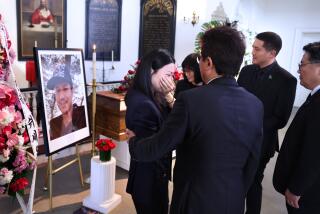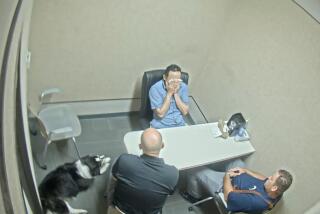Thomas beating a reminder of how quickly things can go awry
I began worrying more than seven years ago, when I first brought him the violins donated by readers.
Would they make my new friend, a Juilliard-trained musician who’d suffered a breakdown 35 years earlier, less safe on the streets of skid row?
Would he be attacked by thieves?
And that was just the beginning of the worries. As I got to know Nathaniel Anthony Ayers better, I fretted not just about whether I could protect him, but also about how to help him.
Time passes; the worries never do. Uncertainty lingers constantly when you have a relationship with someone who has a severe mental illness, and watching the video this week of the Kelly Thomas beating was a reminder of how quickly things can go horribly awry.
Thomas, a 37-year-old homeless man whose entire adult life was a constant struggle with schizophrenia, was settling in for another night on the streets last July when the police approached him. Half an hour later, he was lying on the ground in a pool of his own blood.
My stomach turned as I watched Thomas get mauled by several cops, even though he didn’t appear confrontational when first approached. He did seem to resist as he begged for his life, but no one who can bear to watch the video will be surprised that one cop will be tried on charges of second-degree murder and involuntary manslaughter, and another on involuntary manslaughter and excessive use of force.
“Sorry!” Kelly wailed, to no avail.
“I can’t breathe!” he protested.
The cops were familiar with him, as the first one said, so there had to be some knowledge of his mental state. Yet Thomas was taunted, punched, kicked and clubbed with a baton. One officer is heard saying on the video that he used his Taser and “just smashed his face to hell.”
“Help!” screamed Kelly, who died several days later in the hospital, with brain injuries, shattered bones and a crushed thorax.
“Daddy!”
I don’t know how Kelly’s father, Ron Thomas, was able to watch the video at this week’s preliminary hearing in Orange County Superior Court. We walked back into court together Wednesday morning, and he said the hardest part was hearing the sounds of the beating, as well as his son’s calls to his dad for help.
He has to find the strength to see justice served, Thomas said, and to continue his crusade for reforms that would reduce the chance that another person with a mental illness will meet the same fate.
But how best to accomplish that?
As I have learned these last seven years, people bring strongly differing opinions to the subject. I was convinced at one point by advocates and mental health professionals that my friend Mr. Ayers wouldn’t get better without medication, and that my duty was to push him in that direction even if he was vehemently opposed.
I’ve been asked the same question countless times: “Is he on his meds?”
It’s a natural instinct. We want to think anything can easily be fixed, and I know many people who have recovered their lives through medication.
But other advocates and professionals argued — and ultimately convinced me — that forced treatment might be the worst course of action for my friend, that the meds don’t always work or do the job for very long, and that coercion could destroy the trust I’d built and leave him far more isolated and alienated.
I backed off, choosing to leave those decisions to a respected skid row mental health agency. When Mr. Ayers is doing well, I’m grateful for his remarkable success and the supportive environment he lives in to this day. When he reels and rages and seems a danger to himself if not to others, I wonder again if I’ve served his best interests, if I’ve done enough to protect him from being the next Kelly Thomas.
And the one thing that eludes me is a clear answer to any of it.
What I have learned is that no one medication or treatment plan or philosophy works for everyone. I hope policymakers keep this in mind as they struggle to figure out what Kelly Thomas’ death teaches us.
There have been calls for broader implementation of Laura’s Law, named for a young woman who was shot and killed by a man who had resisted psychiatric treatment. The law calls for court-ordered, assisted outpatient treatment of someone who has refused voluntary services and has a history of hospitalizations, jailings, violence or threats.
“We need a system people want to participate in, but when somebody can’t participate because of the severity of their illness, we as a society owe them our support and interventions,” Carla Jacobs, a Laura’s Law advocate, told me when I went to visit her in Orange after my trip to the courthouse in Santa Ana. Jacobs’ brother has schizophrenia and she doesn’t know where he is or if he’s even alive, and she is married to a man whose mother was killed by his mentally ill sister, so she comes to this with pain and passion and a desire to help.
I couldn’t agree more that for some people, Laura’s Law can be a lifesaver. But the coercive nature of the approach and potential legal challenges to it based on patient rights, along with funding problems and other considerations, have meant that it’s virtually unused except in Nevada County and a small pilot program in Los Angeles County. And as I see it, many people who need help wouldn’t meet the standards or necessarily benefit, including Nathaniel Ayers and perhaps even Kelly Thomas.
Still, it’s worth examining ways in which aspects of Laura’s Law might be implemented successfully and more broadly, along with other alternatives to costly hospitalization and incarceration.
More outreach to those in need, more housing, more supportive services, more monitoring, better healthcare. And not just more training of police on how to handle contacts with those who have a mental illness, but dedicated mental health units like the one used by the LAPD.
Between January and March of this year, more than 1,100 calls to police involving someone with a mental illness have led to responses by a team that includes a specially trained police officer and a mental health professional, according to Lt. Lionel Garcia, who heads the unit. His four response teams help manage these clients after the fact, making sure service links are available and monitoring the progress of clients.
I’ll have more on how it all works sometime soon.
In the meantime, I’ll be thinking of the Thomas family, worrying about those who might suffer the same fate and hoping we can find the collective will to do better — far better than we have — for those who are at risk through no fault of their own.
More to Read
Sign up for Essential California
The most important California stories and recommendations in your inbox every morning.
You may occasionally receive promotional content from the Los Angeles Times.











